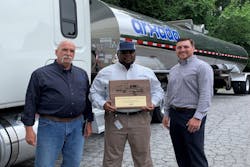Tank truck drivers today are receiving record-setting pay, increased benefits, improved working conditions, and better training.
So it's puzzling that, even armed with these impactful resources, a dearth of commercial drivers persists. The driver shortage and driver retention again were the top two industry issues in the American Transportation Research Institute’s annual report last year, reflecting a constant and troubling reality for U.S. transportation stakeholders. So it may be that these problems remain because the industry isn’t paying enough attention to the importance of organizational culture—and its affective influence on job satisfaction.
To this point, many articles outline possible causations for commercial driver shortages. Many of them cover areas such as the relatively high average age of the existing workforce, failure to attract all segments of the population, the difficulty of finding candidates who are eligible or meet specific hiring guidelines, and industry-related driver churn (a term used to describe employees moving from one organization to another).
In addition, current research doesn’t fully examine the impact organizational culture has on driver retention as an outcome variable. From this perspective, it’s paramount to explore organizational culture within the transportation industry, because culture is deeply rooted in beliefs and values, wherein individuals hold a substantial investment as the result of analyzing and processing data about their workplace lives.
For this reason, the beliefs or notions of organizational culture often are referred to in terms associated with people, places, myths, rites, languages, and practices. Under those circumstances, organizational cultures are considered the building blocks of societies, and the main dynamic that drives collective actions within the workplace. On his theory of cultural value orientations, social psychologist Shalom H. Schwartz wrote in 2014 that if the majority of individuals within an organization follow current missions and strategies, then the culture of the organization is considered “good.” Alternatively, he argued, if individuals do not conform to organizational missions and strategies, the culture of the organization is “bad.”
With this in mind, are organizational cultures within the transportation industry a major contributing factor for labor disruptions that cause negative influences toward driver retention?
During my time in the industry, I’ve seen some organizational cultures that are so ubiquitous they simply fade into the background—and their impact in the workplace goes unnoticed. And if there are no workplace practices within a company that attempt to increase job satisfaction, then the relationships between the organization and its drivers could be negatively impacted. Put another way, job satisfaction is a judgement made about the workplace that creates an emotional experience, and is defined by individual attachments that drivers have with their jobs, so it’s imperative to examine the type of culture exemplified by driver managers and dispatchers. It’s also highly recommended that workplace culture includes day-to-day operational practices that promote job satisfaction, and influence long-term affective commitment from drivers.
Here are a few practices that can help managers improve organizational culture:
Carefully select front-line employees
- Driver managers, dispatchers, and related staff are critical. They exhibit the workplace culture that dominates the organization.
- These critical employees must have direct experience within trucking, because inexperienced employees without industry knowledge frustrate drivers.
- Front-line staff must be sociable because most drivers work in solitude and thus enjoy long conversations about a variety of topics.
Show drivers straight-forward appreciation
- Make sure the organization is attached to industry networks that promote driver safety, retention, and industry knowledge.
- Prime example: ATA’s National Truck Driver Appreciation Week, this year set for Sept. 11-17.
- Make sure driver appreciation gifts are practical and not superficial. It’s best to ask a group of drivers for gift suggestions.
Plan routes and trips thoughtfully
- Send drivers on routes and trips that are tailored toward their specific needs (i.e., short haul vs. long haul).
- Understand not all drivers are alike. It’s important for managers to take the time to learn drivers’ individual preferences.
- Monitor changes in major roadways. Collect and preserve this data in case there is a need to communicate it to customers and drivers.
Dr. Dameous Little is the North America transportation manager for chemical manufacturer Arxada.
About the Author
Dameous Little
North America transportation manager
Dr. Dameous Little is the North America transportation manager for chemical manufacturer Arxada. He earned his doctoral degree in business management from the Pace University Lubin School of Business in New York and has held numerous leadership roles within the chemical and food industries, including the Colorado Boxed Beef Company, Lonza, Pilgrim’s Pride, and Smithfield Foods.
